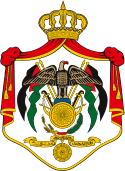Hashemite
 |
|
| Country | Jordan and Iraq |
|---|---|
| Ancestral house | Banu Hashim, a branch of the Quraish tribe. |
| Titles | Sharif of Mecca, King of Jordan, King of Iraq, King of Hejaz, King of Syria, Imam of Yemen |
| Founder | Hussein bin Ali, Sharif of Mecca |
| Final sovereign | Faisal II in Iraq, Jordanian branch is extant. |
| Current head | King Abdullah II (Jordan) Ra'ad bin Zeid (Iraq) Shaikh NoorulHasan (India) |
| Founding | 1916 |
| Dissolution | 1958 in Iraq 14 July Revolution. |
| Ethnicity | Arab, Sunni Islam [1] |
Hashemite is the Latinate version of the (Arabic: هاشمي, transliteration: Hāšimī) and traditionally refers to those belonging to the Banu Hashim, or "clan of Hashim", a clan within the larger Quraish tribe. It also refers to an Arab dynasty whose original strength stemmed from the network of tribal alliances and blood loyalties in the Hejaz region of Arabia, along the Red Sea.
Contents |
History
The Hashemites[2] trace their ancestry from Hashim ibn Abd al-Manaf (died c. 510 AD), the great-grandfather of the Islamic prophet Muhammad, although the definition today mainly refers to the descendants of the prophet's daughter, Fatimah.[3] The early history of the Hashemites saw them in a continuous struggle against the Umayyads for control over who would be the caliph or successor to Muhammad. The Umayyads were of the same tribe as the Hashemites, but a different clan. This rivalry eventually would lead to the split between the Sunni and Shia. After the overthrow of the Umayyads, the Abbasids would present themselves as representatives of the Hashemites, as they claimed descent from Abbas ibn Abd al-Muttalib, an uncle of Muhammad. Muhammad's father had died before he was born, and his mother died while he was a child, so Muhammad was raised by his uncle Abu Talib, chief of the Hashemites.[4]
From the 10th century onwards, the Sharif (religious leader) of Mecca and its Emir was by traditional agreement a Hashemite. Before World War I, Hussein bin Ali of the Hashemite Dhawu-'Awn clan ruled the Hejaz on behalf of the Ottoman sultan. For some time it had been the practice of the Sublime Porte to appoint the Emir of Mecca from among a select group of candidates. In 1908, Hussein bin Ali was appointed Emir of Mecca. He found himself increasingly at odds with the Young Turks in control at Istanbul, while he strove to secure his family's position as hereditary Emirs.
During and after World War I
Sharif Hussein ibn Ali rebelled against the rule of the Ottomans during the Arab Revolt of 1916.[5] Between 1917 and 1924, after the collapse of Ottoman power, Hussein bin Ali ruled an independent Hejaz, of which he proclaimed himself king, with the tacit support of the British Foreign Office. His supporters are sometimes referred to as "Sharifians" or the "Sharifian party". His chief rival in the Arabian peninsula was the king of the highlanders on the highland of Najd named Ibn Saud, who annexed the Hejaz in 1925 and set his own son, Faysal bin Abdelaziz Al Saud, as governor. The region was later incorporated into Saudi Arabia.
Hussein bin Ali had five sons:
- Ali, who briefly succeeded to the throne of Hejaz before its loss to the Saud family.
- Abdullah, later became the king of Transjordan, and whose descendants rule the kingdom, that has been known ever since as the Hashemite Kingdom of Jordan.
- Faisal, was briefly proclaimed King of Syria, and ended up becoming King of Iraq.
- Prince Zeid, who moved to Jordan when his brother's grandson was overthrown and murdered in a coup in 1958.
- Hassan, died at a young age.
Other Hashemites today
Today Hashemites have spread in many places where Muslims have ruled, namely Uzbekistan, India, Pakistan, Turkey, and Iran. Most Hasemites in these countries carry the title Sayyid. The Royal family of the Sultanate of Sulu claims Hashemite ancestry currently in the Philippines.They are still influential over the Muslim population of the Philippines. Formally. many members of the Banu Hashim have spread out but so far there has been no attempt to register them all under one record. The Royal Family of Morocco also claims ancestry from Imam Ali but they don't use Hashemite as their dynastic name.
See also
- Hashemite University
- List of Kings of Jordan
- Line of succession to the Jordanian throne
- List of Kings of Iraq
- Line of succession to the Iraqi throne
- Records of the Hashimite Dynasties: A Twentieth-Century Documentary History of the Royal Families of Jordan, Iraq and the Hijaz (15 vols. Archive Editions, 1995). Editor and researcher